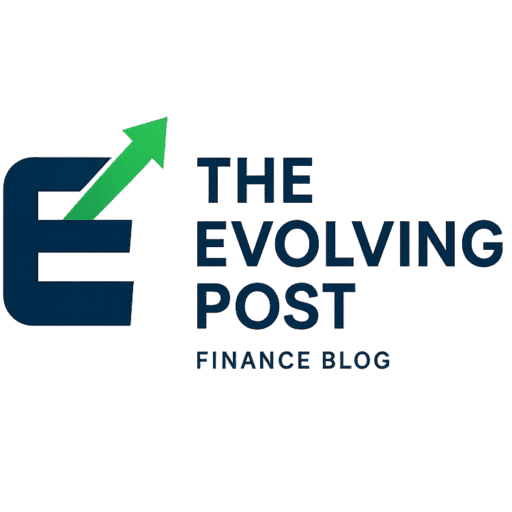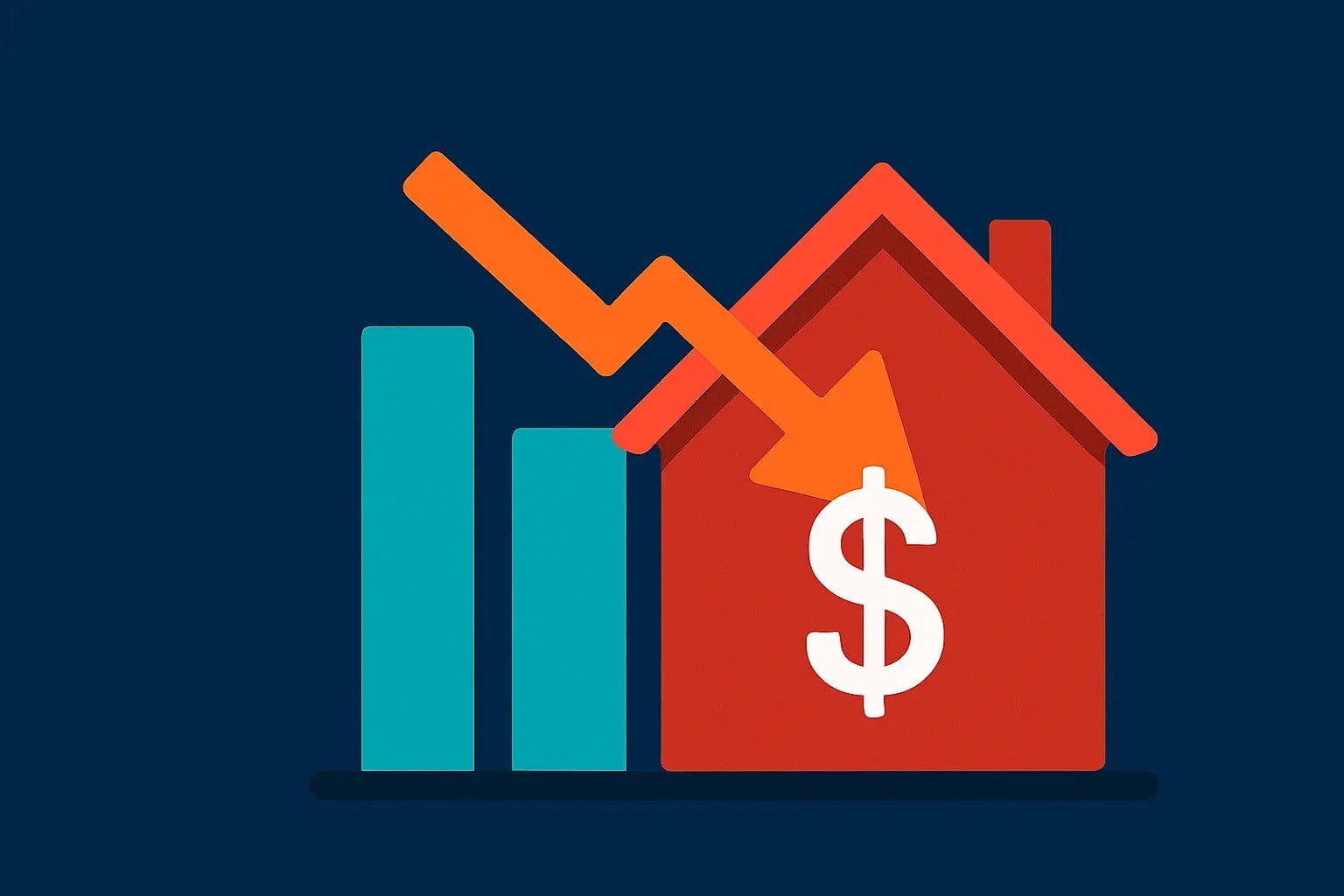The Mortgage Rate Predictions 2025 is at a critical turning point. After years of aggressive rate hikes to combat inflation, both the Federal Reserve and Bank of Canada are signaling a shift toward more accommodative policies. Current 30-year fixed rates in the US hover around 6.7%, while Canadian 5-year fixed rates sit near 3.9%. Understanding where rates are headed can save you thousands of dollars on your mortgage.
Table of Contents
- Current Mortgage Rate Landscape
- US Mortgage Rate Forecast 2025
- Canadian Mortgage Rate Predictions
- Provincial Variations – Provincial
- Key Economic Drivers Shaping Rates
- Monthly Rate Predictions Throughout 2025
- When to Lock Your Mortgage Rate
- Regional Variations and Lender Differences
- Frequently Asked Questions
Current Mortgage Rate Landscape
Where We Stand Today
As of July 10, 2025, the mortgage market reflects the ongoing battle between persistent inflation pressures and cooling economic growth. According to Freddie Mac’s Primary Mortgage Market Survey, the average 30-year fixed mortgage rate stands at 6.72%, representing a slight decline from the 7.1% peak reached in late 2023.
Historical Context
To understand where we’re heading, it’s crucial to see where we’ve been:
- 2020-2021: Rates hit historic lows around 2.5-3.0%
- 2022: Aggressive Fed tightening pushed rates from 3% to 7%
- 2023: Rates peaked at 7.8% in October
- 2024: Gradual stabilization between 6.5-7.2%
- 2025 YTD: Range-bound between 6.6-6.8%
Current Economic Indicators
The latest economic data painting the picture for 2025 includes:
- US Inflation (CPI): 3.2% year-over-year as of June 2025
- Canadian Inflation: 2.8% year-over-year
- US Unemployment: 4.1% (up from 3.5% in 2024)
- Canadian Unemployment: 6.2%
- Fed Funds Rate: 5.25-5.50% (held since July 2024)
- Bank of Canada Rate: 2.75% (cut from 5.0% in 2024)
US Mortgage Rate Forecast 2025
Expert Consensus and Projections
Leading financial institutions and mortgage industry experts have converged on several key predictions for US mortgage rates in 2025:
Major Lender Forecasts
Wells Fargo Mortgage Division projects 30-year fixed rates will:
- Q3 2025: 6.6-6.8%
- Q4 2025: 6.3-6.5%
- Q1 2026: 6.0-6.2%
Quicken Loans Economic Research expects:
- Gradual decline to 6.4% by December 2025
- Potential for brief dips below 6.0% during economic uncertainty
- Return to 6.5% range if inflation resurges
Bank of America Mortgage Insights forecasts:
- Current range of 6.7% to persist through August
- September Fed meeting could trigger 0.25% decline
- Year-end target: 6.2-6.4%
Federal Reserve Policy Impact
The Federal Reserve’s dual mandate of price stability and full employment drives mortgage rate movements. Current Fed communications suggest:
Dovish Signals
- Chair Jerome Powell’s June testimony indicated “progress on inflation”
- Two Fed officials suggested rate cuts possible by September 2025
- Economic data supporting gradual policy normalization
Hawkish Concerns
- Core services inflation remains “sticky” above 4%
- Labor market showing resilience despite cooling
- Geopolitical tensions affecting energy prices
Real-World Impact Examples
Case Study: The Johnson Family (Phoenix, AZ)
The Johnsons are looking to buy a $450,000 home with 20% down ($90,000). Here’s how rate changes affect their monthly payment:
- At 6.7% (current): $2,347/month
- At 6.4% (Q4 forecast): $2,275/month ($72/month savings)
- At 6.0% (optimistic scenario): $2,158/month ($189/month savings)
Over 30 years, a 0.7% rate drop saves them $68,040 in total interest.
Refinancing Opportunities
Current homeowners with rates above 7% should monitor these thresholds:
- Break-even point: Most borrowers need rates to drop 0.5-0.75% below their current rate
- Closing costs: Average $3,000-$5,000 for refinancing
- Optimal timing: When rates hit 6.0% or below for those with 7%+ mortgages
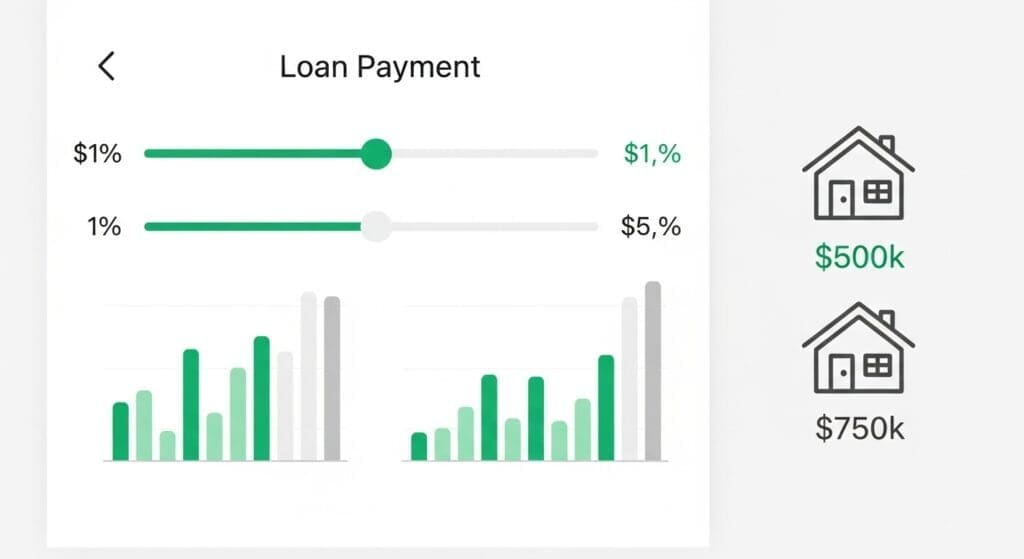
Canadian Mortgage Rate Predictions
Bank of Canada’s Aggressive Easing Cycle
Unlike the US Federal Reserve, the Bank of Canada has already begun cutting rates aggressively. Starting from a peak of 5.0% in July 2024, the BoC has cut rates to 2.75% as of July 2025.
Projected BoC Rate Path
According to Bank of Canada’s Monetary Policy Report, the overnight rate trajectory shows:
- September 2025: 2.50% (0.25% cut expected)
- December 2025: 2.25% (additional 0.25% cut)
- March 2026: 2.00% (final cut in cycle)
Canadian Mortgage Rate Forecasts
5-Year Fixed Rate Predictions
Royal Bank of Canada (RBC) projects:
- Current: 3.89%
- September 2025: 3.79%
- December 2025: 3.69%
- March 2026: 3.59%
TD Bank Economic Research expects:
- More aggressive decline to 3.49% by year-end
- Driven by increased competition among lenders
- Potential for promotional rates below 3.25%
Variable Rate Outlook
Canadian variable rates (typically Prime – 1.00%) are expected to follow BoC cuts directly:
- Current Prime Rate: 4.95%
- September 2025: 4.70%
- December 2025: 4.45%
- Variable Rate (Prime – 1.00%): 3.45% by year-end
Real Canadian Examples
Case Study: The Patel Family (Toronto, ON)
Looking to purchase a $800,000 home with 20% down ($160,000):
- At 3.89% (current 5-year fixed): $3,021/month
- At 3.69% (December forecast): $2,947/month ($74/month savings)
- At 3.45% (variable by December): $2,888/month ($133/month savings)
Renewal Scenario: The Chen Family (Vancouver, BC)
Their $500,000 mortgage renews in October 2025. Currently paying 5.2% (locked in 2020):
- Current payment: $2,950/month
- Renewal at 3.79%: $2,485/month ($465/month savings)
- Annual savings: $5,580
Provincial Variations
Mortgage rates can vary by province due to local economic conditions and lender competition:
Highest Rates (typically 0.1-0.2% above national average):
- Newfoundland and Labrador
- New Brunswick
- Saskatchewan
Lowest Rates (typically 0.1-0.15% below national average):
- Ontario (high competition)
- British Columbia (strong market)
- Alberta (economic recovery)
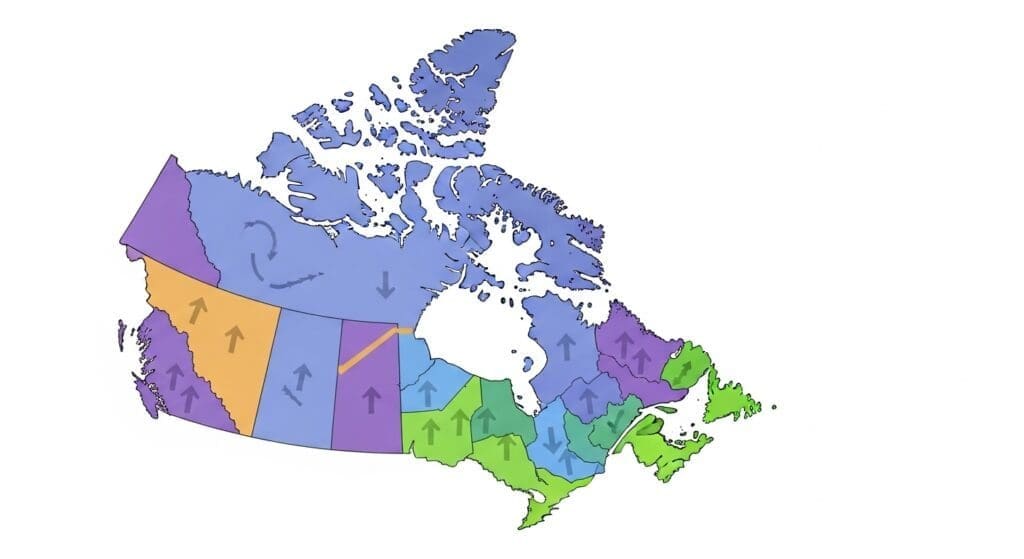
Key Economic Drivers Shaping Rates
Inflation Trends and Central Bank Response
US Inflation Dynamics
The Bureau of Labor Statistics June 2025 report shows:
- Headline CPI: 3.2% (down from 4.1% in January)
- Core CPI: 3.8% (excluding food and energy)
- Services inflation: 4.2% (the “sticky” component)
- Housing costs: 5.1% (largest CPI component)
Fed’s Target: The Federal Reserve aims for 2% inflation, but officials have indicated tolerance for gradual progress rather than immediate achievement.

Canadian Inflation Picture
Statistics Canada data reveals:
- Headline CPI: 2.8% (within BoC’s 1-3% target range)
- Core CPI: 2.4% (closer to 2% target)
- Trimmed mean: 2.6%
- Median CPI: 2.5%
BoC’s Confidence: With inflation closer to target, the Bank of Canada has more flexibility for rate cuts.
Labor Market Conditions
US Employment Landscape
- Unemployment rate: 4.1% (up from 3.5% low)
- Job openings: 8.1 million (down from 12 million peak)
- Wage growth: 4.2% year-over-year (cooling from 5.5% peak)
- Labor force participation: 62.8%
Fed Interpretation: Cooling labor market provides room for rate cuts without triggering wage-price spiral.
Canadian Employment Data
- Unemployment rate: 6.2% (highest since 2022)
- Job creation: Averaging 15,000 monthly (below 25,000 trend)
- Wage growth: 3.8% year-over-year
- Youth unemployment: 12.1% (concerning trend)
Bond Market Influences
Mortgage rates closely track government bond yields, which reflect investor sentiment about economic growth and inflation.
US 10-Year Treasury Trends
- Current yield: 4.15%
- 2025 range: 3.85% – 4.35%
- Spread to mortgage rates: Typically 2.5-2.8%
Canadian 10-Year Government Bond
- Current yield: 3.25%
- 2025 range: 2.95% – 3.45%
- Spread to mortgage rates: Typically 0.6-0.8%
Geopolitical and Economic Risks
Factors Supporting Lower Rates
- Cooling global growth: IMF projects 2.8% global GDP growth (below trend)
- China economic slowdown: Reduced commodity demand
- European recession risks: Affecting global trade
Factors Supporting Higher Rates
- Middle East tensions: Oil price volatility
- US-China trade relations: Potential tariff impacts
- Climate-related supply shocks: Food and energy price spikes
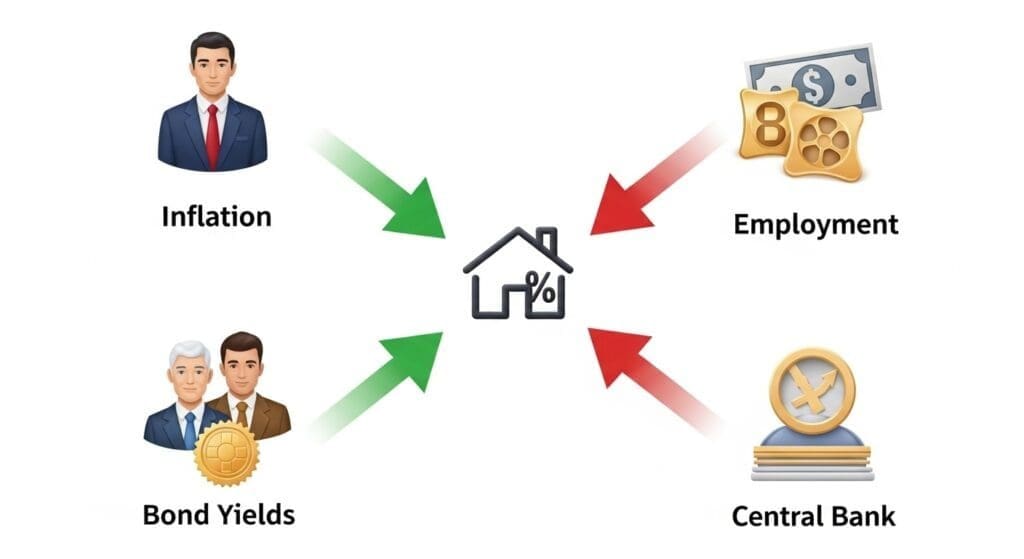
Monthly Rate Predictions Throughout 2025
Detailed Month-by-Month Forecast
United States 30-Year Fixed Rates
July 2025: 6.65-6.75%
- Current range holding steady
- Awaiting July Fed meeting minutes
- Summer buying season supporting demand
August 2025: 6.60-6.70%
- Slight decline on cooling inflation data
- Back-to-school spending monitored
- Jackson Hole symposium influence
September 2025: 6.45-6.55%
- Expected 0.25% Fed rate cut
- Mortgage rates typically decline 0.15-0.20% following Fed cuts
- Fall buying season begins
October 2025: 6.40-6.50%
- Continued gradual decline
- Q3 GDP data influence
- Election year considerations begin
November 2025: 6.35-6.45%
- Potential second Fed cut
- Holiday spending data watched
- Year-end positioning
December 2025: 6.25-6.35%
- Year-end target range
- 2026 outlook begins forming
- Holiday market slowdown
Canada 5-Year Fixed Rates
July 2025: 3.85-3.95%
- Current competitive environment
- Summer market activity
August 2025: 3.80-3.90%
- Gradual lender competition increase
- BoC maintaining dovish stance
September 2025: 3.70-3.80%
- Expected BoC rate cut impact
- Back-to-school market activity
October 2025: 3.65-3.75%
- Continued easing cycle
- Fall market traditionally strong
November 2025: 3.60-3.70%
- Potential additional BoC cut
- Year-end rate shopping
December 2025: 3.55-3.65%
- Year-end competitive rates
- 2026 outlook forming
Seasonal Patterns and Market Dynamics
Spring Market (March-May)
- Highest activity period: Rates often 0.1-0.2% higher due to demand
- Inventory increases: More negotiating power for buyers
- Rate lock timing: Consider locking 60-90 days ahead
Summer Market (June-August)
- Moderate activity: Rates typically stable
- Family moving season: Sustained demand
- Vacation impact: Some lender capacity constraints
Fall Market (September-November)
- Second peak season: Rates may tick up slightly
- School year starts: Family relocations
- Rate shopping: Increased competition among lenders
Winter Market (December-February)
- Slowest period: Often best rates available
- Limited inventory: Less competition among buyers
- Lender promotions: Year-end and New Year specials
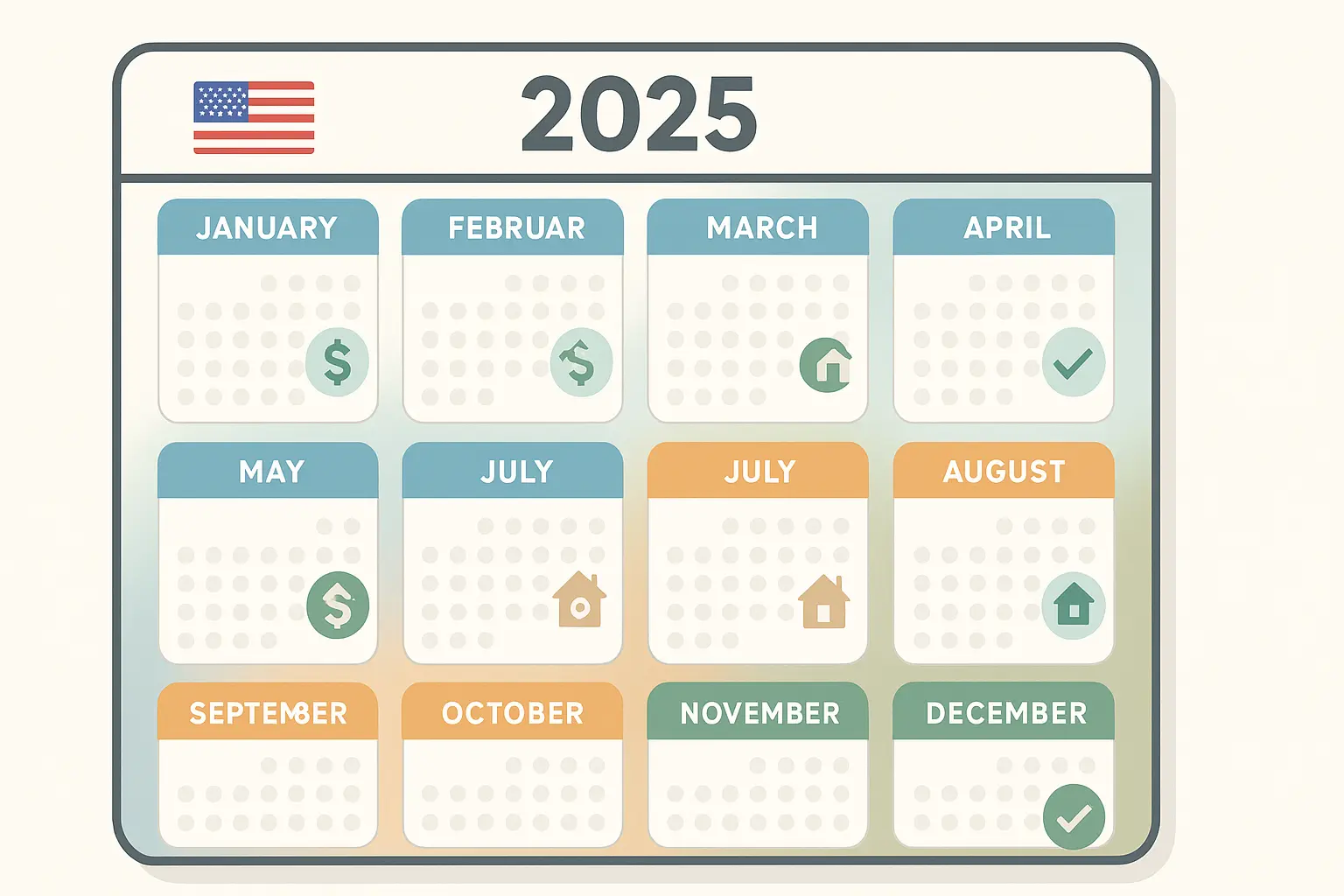
When to Lock Your Mortgage Rate
Understanding Rate Lock Strategies
US Rate Lock Considerations
Standard Lock Periods:
- 30 days: Most common, usually free
- 45 days: Small fee (0.125-0.25% of loan amount)
- 60 days: Moderate fee (0.25-0.375% of loan amount)
- 90 days: Higher fee (0.375-0.5% of loan amount)
Optimal Timing Scenarios:
Scenario 1: First-Time Homebuyer
Example: Sarah, 28, teacher in Austin, TX
- Current situation: Pre-approved at 6.7%, house hunting
- Strategy: Lock when rates drop to 6.5% or below
- Timeline: 45-day lock for active searching
- Cost-benefit: $150 lock fee vs. potential $200/month savings
Scenario 2: Refinancing Homeowner
Example: Mike and Lisa, 45, Denver, CO
- Current mortgage: 7.2% from 2023
- Break-even point: Need rates at 6.5% or below
- Strategy: Monitor daily, lock immediately when threshold hit
- Timeline: 30-day lock sufficient for refinance
Canadian Rate Lock Strategies
Rate Hold Periods:
- 90 days: Standard offering from major banks
- 120 days: Available from some credit unions
- 150 days: Premium service from select lenders
Optimal Timing Examples:
Scenario 1: New Home Purchase
Example: The Kumar Family, Calgary, AB
- Current pre-approval: 3.89% for 90 days
- Strategy: Monitor BoC announcements, re-lock if rates drop
- Benefit: Can secure lower rate if available during hold period
Scenario 2: Mortgage Renewal
Example: Jennifer, 52, Halifax, NS
- Current rate: 5.4% (expires December 2025)
- Strategy: Lock new rate 120 days before renewal
- Expected savings: From 5.4% to 3.7% = $380/month on $300k mortgage
Rate Lock Decision Framework
When to Lock Immediately
- Rates are at or near your target level
- You’ve found your home and have an accepted offer
- Economic data suggests rates may rise
- You have a short closing timeline (30-45 days)
When to Wait
- Rates are trending downward
- Major economic announcements pending (Fed/BoC meetings)
- You’re still house hunting (no immediate need)
- Lock fees are high relative to potential savings
When to Consider Float-Down Options
Some lenders offer “float-down” provisions allowing you to capture lower rates even after locking:
Typical Terms:
- Fee: 0.25-0.50% of loan amount
- Minimum drop: Usually 0.25% or more
- One-time use: Can only exercise once during lock period
Cost-Benefit Analysis:
On a $400,000 loan:
- Float-down fee: $1,000-$2,000
- Break-even: Need 0.25% rate drop
- Monthly savings at 0.25% drop: ~$60/month
- Payback period: 17-33 months
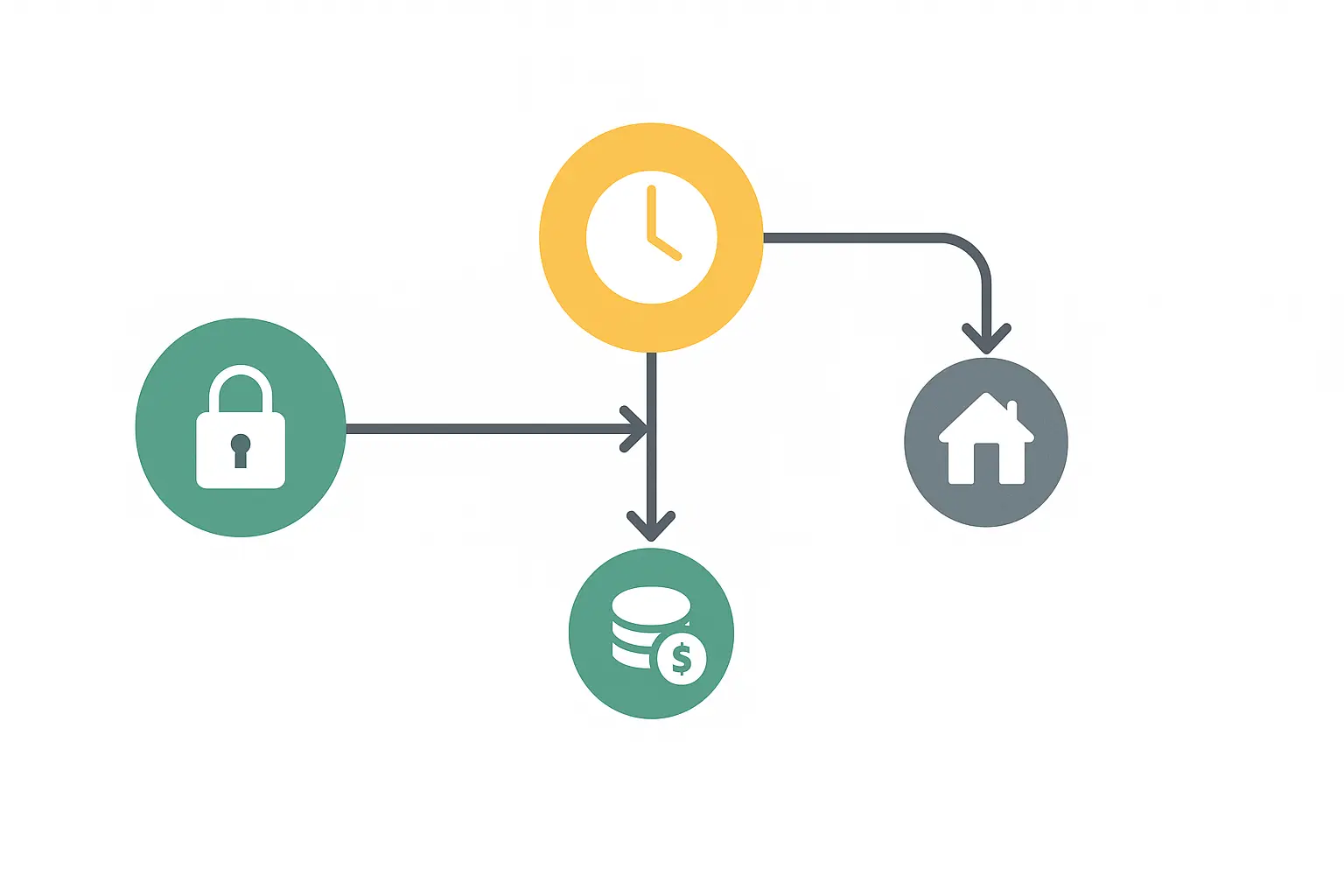
Regional Variations and Lender Differences
US Regional Rate Variations
High-Cost Markets (typically 0.1-0.2% higher rates)
California:
- Average 30-year fixed: 6.8-6.9%
- Jumbo loan rates: 6.9-7.1%
- Reasons: High loan amounts, regulatory costs, earthquake risk
New York Metro:
- Average 30-year fixed: 6.75-6.85%
- Co-op/condo considerations: Additional 0.1-0.2%
- Reasons: Complex property types, high taxes
Hawaii:
- Average 30-year fixed: 6.9-7.0%
- Reasons: Geographic isolation, limited lender competition
Competitive Markets (typically 0.1-0.15% lower rates)
Texas:
- Average 30-year fixed: 6.55-6.65%
- Reasons: No state income tax, business-friendly environment
Florida:
- Average 30-year fixed: 6.6-6.7%
- Reasons: High competition, no state income tax
North Carolina:
- Average 30-year fixed: 6.6-6.7%
- Reasons: Growing market, competitive lender landscape
Lender Type Differences
Traditional Banks
Examples: Wells Fargo, Bank of America, Chase
- Rates: Typically at market average
- Pros: Relationship banking, branch access, established processes
- Cons: Less flexibility, potentially higher fees
Rate Example (30-year fixed):
- Wells Fargo: 6.72%
- Bank of America: 6.75%
- Chase: 6.71%
Credit Unions
Examples: Navy Federal, PenFed, Local credit unions
- Rates: Often 0.1-0.25% below banks
- Pros: Member-focused, lower fees, competitive rates
- Cons: Membership requirements, limited locations
Rate Example (30-year fixed):
- Navy Federal: 6.55%
- PenFed: 6.50%
- Local CU average: 6.45%
Online Lenders
Examples: Rocket Mortgage, Better.com, LoanDepot
- Rates: Highly competitive, often lowest available
- Pros: Fast processing, technology-driven, competitive pricing
- Cons: Limited personal service, potential technology issues
Rate Example (30-year fixed):
- Rocket Mortgage: 6.45%
- Better.com: 6.40%
- LoanDepot: 6.50%
Mortgage Brokers
- Access: Multiple lender options
- Rates: Can find best available rates
- Pros: Shopping convenience, expert guidance
- Cons: Broker fees, potential conflicts of interest
Canadian Lender Landscape
Big Six Banks
Rate Consistency: Major banks typically within 0.05% of each other
Current 5-Year Fixed Rates:
- RBC: 3.89%
- TD: 3.94%
- Scotiabank: 3.89%
- BMO: 3.92%
- CIBC: 3.91%
- National Bank: 3.87%
Credit Unions and Alternative Lenders
Examples: Meridian, Coast Capital, First National
- Rates: Often 0.1-0.2% below big banks
- Pros: Competitive rates, personalized service
- Cons: Limited geographic reach, smaller market presence
Sample Rates:
- Meridian Credit Union: 3.79%
- Coast Capital: 3.82%
- First National: 3.75%
Mortgage Brokers (Canada)
- Market share: ~35% of Canadian mortgages
- Access: 50+ lenders including banks, credit unions, private lenders
- Typical savings: 0.1-0.3% below bank posted rates
Impact on Different Types of Borrowers
First-Time Homebuyers
US First-Time Buyer Challenges
Affordability Crisis:
- Median home price: $420,000 (July 2025)
- Required income at 6.7% rate: $105,000 annually
- Down payment (10%): $42,000
- Monthly payment: $2,650 (principal, interest, taxes, insurance)
Rate Impact Example:
Jessica, 26, nurse in Phoenix earning $65,000
- At 6.7%: Qualifies for $280,000 home
- At 6.0%: Qualifies for $315,000 home ($35,000 more buying power)
First-Time Buyer Programs:
- FHA loans: 3.5% down, rates typically 0.25% higher than conventional
- VA loans: 0% down for veterans, rates often 0.1-0.2% lower
- USDA loans: 0% down in rural areas, competitive rates
- State programs: Down payment assistance, varying rate benefits
Canadian First-Time Buyer Advantages
Government Support:
- First-Time Home Buyer Incentive: Shared equity program
- Home Buyers’ Plan: RRSP withdrawal up to $35,000
- Land Transfer Tax Rebates: Provincial programs
Rate Impact Example:
David and Emma, 29, teachers in Ottawa earning $95,000 combined
- At 3.89%: Qualify for $450,000 home
- At 3.59%: Qualify for $485,000 home ($35,000 more buying power)
Refinancing Homeowners
US Refinancing Landscape
Current Refinance Activity:
- Refinance share: 28% of total mortgage applications (down from 70% in 2020-2021)
- Average loan size: $375,000
- Break-even timeline: 18-24 months typical
Refinancing Scenarios:
High-Rate Borrowers (7%+ current rate):
Tom and Maria, Phoenix, $500,000 loan at 7.2%
- Current payment: $3,348/month
- At 6.5%: $3,160/month ($188/month savings)
- Break-even: 16 months with $3,000 closing costs
- 30-year savings: $67,680
Moderate-Rate Borrowers (6.5-7% current rate):
Jennifer, Austin, $300,000 loan at 6.8%
- Current payment: $1,975/month
- At 6.3%: $1,864/month ($111/month savings)
- Break-even: 22 months with $2,500 closing costs
- Decision: Wait for rates below 6.0% for better savings
Canadian Renewal Opportunities
Renewal Timeline:
- Average mortgage term: 5 years
- 2025 renewal volume: 1.2 million mortgages
- Average renewal rate drop: 1.5-2.0% for 2020 originations
Renewal Example:
The Singh Family, Toronto, $600,000 mortgage
- 2020 rate: 2.8% (pandemic low)
- 2025 renewal rate: 3.7%
- Payment increase: $450/month
- Strategy: Consider variable rate at 3.45% to minimize increase
Investment Property Owners
US Investment Property Rates
Rate Premiums:
- Single-family rental: +0.5-0.75% above owner-occupied
- Multi-family (2-4 units): +0.75-1.0%
- Commercial (5+ units): +1.0-1.5%
Current Investment Rates:
- Single-family: 7.2-7.4%
- Multi-family: 7.4-7.6%
- Cash-out refinance: +0.25% additional
Investment Strategy Impact:
Real estate investor with 4 rental properties
- At 7.3% rates: Cash flow negative on new acquisitions
- At 6.8% rates: Marginal cash flow positive
- At 6.3% rates: Strong cash flow, expansion viable
Canadian Investment Property Considerations
Rate Premiums:
- Investment property: +0.2-0.4% above owner-occupied
- Non-resident buyers: +1.0-2.0% additional
Current Investment Rates:
- Resident investor: 4.1-4.3%
- Non-resident: 5.1-5.9%
High-Net-Worth Borrowers
Jumbo Loan Rates (US)
Loan Limits (2025):
- Most areas: $766,550
- High-cost areas: $1,149,825 (San Francisco, NYC, etc.)
Jumbo Rate Premiums:
- Conforming loan: 6.72%
- Jumbo loan: 6.85% (+0.13% premium)
- Super jumbo ($2M+): 7.0-7.2%
Canadian High-Ratio vs. Conventional
High-Ratio (less than 20% down):
- Rate: 3.89% (insured)
- Insurance cost: 2.8-4.0% of loan amount
Conventional (20%+ down):
- Rate: 3.94% (uninsured)
- No insurance required
- Better rate negotiation power
Frequently Asked Questions
Will mortgage rates drop below 6% in the US during 2025?
Most experts believe there’s a 30-40% chance of seeing rates briefly touch the high 5% range during 2025, particularly if economic data shows significant cooling. However, sustained rates below 6% are unlikely unless there’s an unexpected economic downturn.
The key factors that could push rates below 6%:
- Unemployment rising above 4.5%
- Inflation falling below 2.5% consistently
- Significant geopolitical crisis causing flight to safety
- Major recession fears
Most likely scenario: Rates bottom out around 6.0-6.2% in late 2025 or early 2026.
Should I wait for lower rates or buy now?
This depends on your specific situation, but here’s the framework most experts recommend:
Buy now if:
- You plan to stay in the home 5+ years
- You can comfortably afford current payments
- You’re renting and paying similar to mortgage costs
- You can refinance later when rates drop
Wait if:
- You’re stretching financially at current rates
- You’re not sure about long-term plans
- You expect significant income changes
- Local market shows signs of price declines
Remember: You can “marry the house, date the rate” – refinance when rates improve.
How much do mortgage rates need to drop to make refinancing worthwhile?
The traditional rule of thumb is 0.75-1.0% rate reduction, but this depends on several factors:
Break-even calculation:
- Closing costs: $3,000-$5,000 typical
- Monthly savings needed: $250-$400 to break even in 12-18 months
- Rate drop required: Usually 0.5-0.75% for most borrowers
Example: $400,000 loan at 7.0%
- Need rate of: 6.25% or lower
- Monthly savings: $200+
- Break-even: 15-20 months
Are Canadian mortgage rates expected to go lower than US rates?
Yes, this trend is expected to continue throughout 2025. Several factors support this:
Structural differences:
- Canadian banking system: More regulated, stable funding costs
- Government bond yields: Canadian 10-year typically 0.5-1.0% below US
- Economic cycles: Canada ahead of US in rate-cutting cycle
- Currency factors: Strong USD supports higher US rates
Expected spread: Canadian 5-year fixed rates likely to remain 2.5-3.0% below US 30-year fixed rates.
What’s the difference between variable and fixed rates in Canada?
Fixed Rate (5-year):
- Current: 3.89%
- Stability: Payment stays same for 5 years
- Risk: Higher if rates fall significantly
- Best for: Risk-averse borrowers, budget certainty
Variable Rate:
- Current: 3.95% (Prime – 1.00%)
- Flexibility: Moves with Bank of Canada rate changes
- Risk: Payments can increase if rates rise
- Best for: Risk-tolerant borrowers expecting rate cuts
2025 Outlook: Variable rates likely to be lower by year-end due to expected BoC cuts.
How do mortgage rate predictions affect home prices?
There’s typically an inverse relationship between mortgage rates and home prices:
Rate decreases often lead to:
- Increased buyer purchasing power
- Higher demand for homes
- Upward pressure on prices
- More refinancing activity
Rate increases often lead to:
- Reduced buyer purchasing power
- Lower demand
- Price stabilization or declines
- Reduced refinancing
2025 Prediction: Modest rate declines may support price stability rather than significant increases, as affordability remains challenged.
Should I choose a 15-year or 30-year mortgage in the current environment?
15-year mortgages typically offer:
- Rate advantage: 0.5-0.75% lower than 30-year
- Current rates: Around 6.0-6.2%
- Total interest savings: Significant over loan life
- Higher monthly payments: 40-50% more than 30-year
30-year mortgages provide:
- Lower payments: Better cash flow flexibility
- Current rates: Around 6.7%
- Refinancing opportunity: Can pay extra or refinance to shorter term later
Recommendation for 2025: Most experts suggest 30-year mortgages given rate uncertainty, with option to make extra principal payments or refinance to 15-year when rates drop.
How accurate are these mortgage rate predictions?
Mortgage rate forecasting has inherent limitations:
Historical accuracy:
- 6-month forecasts: Typically within 0.5% of actual rates
- 12-month forecasts: Often within 0.75-1.0%
- Beyond 12 months: Accuracy decreases significantly
Factors affecting accuracy:
- Unexpected economic events (pandemic, geopolitical crises)
- Central bank policy surprises
- Market sentiment shifts
- Global economic developments
Best approach: Use predictions as general guidance, but be prepared for volatility and have contingency plans for different rate scenarios.
Want to Keep Strengthening Your Finances?
If you found this article helpful, you might enjoy some of our other popular posts that dive deeper into saving, investing, and smart money management:
- 6 Financial Strategies to Protect Your Wealth
- Best No-Penalty CD Rates of 2025
- Best High-Yield Savings Accounts 2025
- 8 Powerful Financial Strategies Every Single Person Should Know
- The 10 Best Financial Wellness Apps That Track Mental Health in 2025
- 2025 401(k) Limits: Save $34,750 + Super Catch-Up Guide
Keep exploring — your smartest financial years are just getting started.
Sources:
- Freddie Mac Primary Mortgage Market Survey
- Federal Reserve Economic Data (FRED)
- Bank of Canada Monetary Policy Report
- Bureau of Labor Statistics Consumer Price Index
- Statistics Canada Consumer Price Index
- Mortgage Bankers Association Forecast
- National Association of Realtors Economic Research
- Wells Fargo Economics Group
- RBC Economics Research
- TD Economics
Disclaimer: This article is for educational purposes only and does not constitute financial or investment advice. Mortgage rates are subject to change based on market conditions, individual creditworthiness, and lender policies. Always consult with qualified mortgage professionals and compare multiple lenders before making financing decisions. Past performance and predictions do not guarantee future results.
